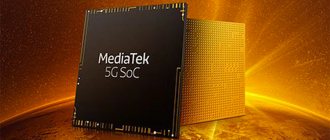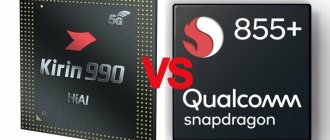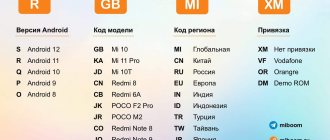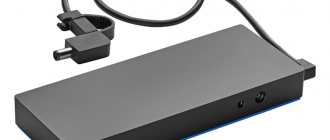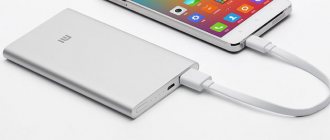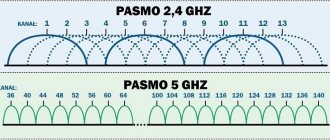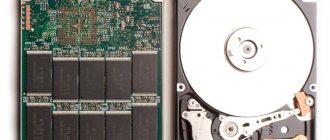MediaTek processors are among the most popular, and this is not surprising - the chipsets of the Chinese company are much cheaper than their counterparts from Qualcomm (we have not found official confirmation of this, but it cannot be otherwise from a logical point of view). Since there are so many MediaTek single-chip systems, we decided to compare them with each other, since the rule “the higher the numerical index of the chipset, the cooler it is” does not always work. In this article, we will review only current (to one degree or another) chipsets produced no later than 2015, information about which is on the official website.
Subscribe to our Telegram
Subscribe to our Telegram
What really matters in processors
In this article, we will not compare absolutely all technical characteristics of chipsets, since most of them are not important when choosing mobile devices: for example, information about the maximum camera resolution supported by the processor or the ability of a single-chip system to work with LPDDR4X memory will not help a person in any way when choosing gadget (since the buyer is purchasing a smartphone or tablet with a camera and memory already installed, and not a computer where, if desired, any components can be replaced - even if the processor installed in the mobile device supports the best components, this is absolutely unimportant).
Processor characteristics that you should pay attention to when purchasing a device:
- Technical process: chipset manufacturing technology, characterized by the resolution of the equipment used in the production of processors. Simply put, the fewer nanometers (nm), the better: cores created using the 7 nm process are more economical than their 10 nm counterparts, all other characteristics being equal.
- Core Clock Speed: Shows the number of operations performed per second and is measured in Hertz (Hz). The higher it is, the more productive the processor cores are.
- Number of cores: the more cores, the less the chipset is overloaded - all thanks to the better ability to distribute processes across multiple cores.
- Number and composition of clusters: to increase the energy efficiency of processors, cores with the same performance are installed in separate clusters. This allows you to separate productive cores from economical ones, so that resource-intensive tasks are performed only by “powerful” cores, and simple tasks are performed exclusively by low-performance cores. Most processors are built in a two-cluster format, but the company equipped all single-chip systems of the flagship Helio X series with three clusters: in addition to productive and economical cores, the chipsets contain medium-power cores. In theory, the more clusters, the more economical the processor.
- Graphics accelerator: This is an integrated video card in a smartphone, installed on the same board as the processor. The rule “the higher the numerical index of the graphics processor, the better” often works here, but video accelerators can also be compared by maximum frequency.
Conclusion
The Redmi 6A powered by MediaTek Helio A22 is certainly not a giant step forward compared to the Redmi 5A powered by Snapdragon 425. In everyday use, the difference in performance of these devices is practically not noticeable. But when processing heavy graphics, the newer Helio A22 still has some advantage over the 425th Snap. At least, this device can handle “Tanks” at medium settings with an fps of 30-50 frames per second.
Although, frankly speaking, Redmi 6A is still not a gaming model. And Xiaomi engineers didn’t think of it as a gaming game. The company produces other (more expensive) solutions for gamers. But on this budget device you can only play “out of nothing to do.” But for solving simpler problems its performance is sufficient without question (again, taking into account the price of this device).
In our other material you can find a more detailed comparison of the Xiaomi Redmi 5A and Redmi 6A.
Helio X - flagship models
| Characteristics | Helio X30 (2017) | Helio X27 (2017) | Helio X25 (2015) | Helio X23 (2017) | Helio X20 (2015) |
| Technical process | 10 nm (FF+) | 20 nm (HPM) | 20 nm (HPM) | 20 nm (HPM) | 20 nm (HPM) |
| Cores | 2 × 2.5 GHz (Cortex-A73) 4 × 2.2 GHz (Cortex-A53) 4 × 1.9 GHz (Cortex-A35) | 2 × 2.6 GHz (Cortex-A72) 4 × 2 GHz (Cortex-A53) 4 × 1.6 GHz (Cortex-A53) | 2 × 2.5 GHz (Cortex-A72) 4 × 2 GHz (Cortex-A53) 4 × 1.6 GHz (Cortex-A53) | 2 × 2.3 GHz (Cortex-A72) 4 × 1.85 GHz (Cortex-A53) 4 × 1.4 GHz (Cortex-A53) | 2 × 2.1 GHz (Cortex-A72) 4 × 1.85 GHz (Cortex-A53) 4 × 1.4 GHz (Cortex-A53) |
| Graphics accelerator | PowerVR 7XTP-MT4(up to 850 MHz) | Mali-T880 MP4(up to 875 MHz) | Mali-T880 MP4(up to 850 MHz) | Mali-T880 MP4(up to 780 MHz) | Mali-T880 MP4(up to 780 MHz) |
| Popular smartphones with this processor | Meizu Pro 7 / Pro 7 Plus | Ulefone Gemini Pro LeEco Le 3 Pro | Xiaomi Redmi Pro Meizu Pro 6/6s | Lenovo K8 Note | Xiaomi Redmi Note 4 Meizu MX6 |
In 2022, MediaTek temporarily suspended the production of flagship processors as they were not in demand among mobile device manufacturers. As a result, models with indexes 23, 27 and 30, released in 2017, became the latest current representatives of the Helio X series.
As you would expect, the most productive is the X30 - it is much more attractive than its predecessor in all respects and is the only processor from MediaTek created using a 10-nanometer process technology. If you choose a device with a Helio X series chipset, then you should give preference to models with X30.
Surprisingly, the 2022 Helio X27 and X23 are practically no different from their 2015 predecessors in the X25 and X20 - the new products have slightly overclocked cores, as well as the frequency of the same graphics accelerator. As a result, these processors can be considered equivalent (if you are not chasing an additional 5 FPS in games).
Despite everything, we do not recommend choosing devices based on the chipsets described above, since these MediaTek developments are already outdated. Better take a closer look at gadgets based on Helio P processors.
Helio P22 - release date, which smartphones it will appear in
The chipset itself for mobile devices has not only been developed, but is already being successfully manufactured in factories, so its appearance in smartphones is expected no later than June. At the moment, it is based on one single smartphone, Vivo Y83.
As for manufacturers who will actively use the new platform, Mediatek remains silent here, but it is not difficult to guess who will be interested in the chip. So the main buyers will be Lenovo, Huawei, Honor and many lesser-known brands, such as Blackview, Bluboo, Ulefone and others. As for Meizu, it can install a new solution in some gadgets, but there is no need to talk about widespread use. After the Mediatek Helio X line of processors failed miserably, Meizu decided to focus on Snapdragon.
Helio P - middlings that eclipsed the flagships
| Characteristics | Helio P90 (2019) | Helio P70 (2018) | Helio P60 (2018) | Helio P35 (2019) | Helio P30 (2017) | Helio P25 (2017) | Helio P23 (2017) | Helio P22 (2018) | Helio P20 (2016) | Helio P18 (2018) | Helio P10 (2015) |
| Technical process | 12 nm (HPM) | 12 nm (HPM) | 12 nm (HPM) | 12 nm (HPM) | 16 nm (FFC) | 16 nm (FFC) | 16 nm (FFC) | 12 nm | 16 nm (FFC) | 28 nm (NPC+) | 28 nm (NPC+) |
| Cores | 2 × 2.2 GHz (Cortex-A75) 6 × 2 GHz (Cortex-A55) | 4 × 2.1 GHz (Cortex-A73) 4 × 2 GHz (Cortex-A53) | 4 × 2 GHz (Cortex-A73) 4 × 2 GHz (Cortex-A53) | 8 × 2.3 GHz (Cortex-A53) | 4 × 2.3 GHz (Cortex-A53) 4 × 1.65 GHz (Cortex-A53) | 4 × 2.6 GHz (Cortex-A53) 4 × 1.6 GHz (Cortex-A53) | 4 × 2.3 GHz (Cortex-A53) 4 × 1.65 GHz (Cortex-A53) | 8 × 2 GHz (Cortex-A53) | 4 × 2.3 GHz (Cortex-A53) 4 × 1.6 GHz (Cortex-A53) | 8 × 2 GHz (Cortex-A53) | 4 × 2 GHz (Cortex-A53) 4 × 1.2 GHz (Cortex-A53) |
| Graphics accelerator | PowerVR GM9446(up to 970 MHz) | Mali-G72 MP3(up to 900 MHz) | Mali-G72 MP3(up to 800 MHz) | PowerVR GE8320(up to 680 MHz) | Mali-G72 MP2(up to 950 MHz) | Mali-T880 MP2(up to 1 GHz) | Mali-G71 MP2(up to 770 MHz) | PowerVR GE8320(up to 650 MHz) | Mali-T880 MP2(up to 900 MHz) | Mali-T860 MP2(up to 800 MHz) | Mali-T860 MP2(up to 700 MHz) |
| Popular smartphones with this processor | Ulefone T3 | OPPO A9X OPPO F11/F11 Pro Vivo V15 realme 3 | Nokia 5.1 Plus OPPO R15 OPPO F9 | Xiaomi Mi Play Honor Play 8A OPPO A7n | Gionee M7 | Meizu Pro 7 Doogee Mix 2 Blackview BV9000 | OPPO F5 OPPO A79 Alcatel 7 | Nokia 3.1 Plus Sony Xperia L3 LG Q60 | Meizu E2 Xony Xperia XA1 / XA1 Plus / XA1 Ultra | Nokia 5.1 | Meizu M5 Note Meizu M3E/M3 Max Lenovo K5 Note Sony Xperia XA Ultra |
In recent years, MediaTek has been actively developing the mid-range Helio P series, thanks to which it currently has 11 current models (no older than 2015). The new products in this line are superior to the representatives of the flagship Helio X series.
The most productive is Helio P90 , as it has advanced Cortex-A75 and Cortex-A55 cores, as well as a PowerVR GM9446 video accelerator with a frequency of up to 970 MHz.
Following the top model of the series are Helio P70 and P60 . The performance of their cores is almost the same, but the overclocking of the same graphics accelerator varies significantly: up to 900 and 800 MHz, respectively. The difference between these two processors will only be noticeable in demanding games.
Helio P35 and P22 are also quite similar: they are created using the same technical process, they have the same video accelerator (with a slight difference in frequency) and they are both equipped with the same cluster with eight Cortex-A53 cores. The key difference is the core speed: 2.3 GHz for the P35 versus 2 GHz for the P22. If you are not going to spend all your time playing games with your smartphone, then there is no point in overpaying for a gadget with P35.
Helio P30 , P25 , P23 and P20 can be called twin brothers. P25 is the most powerful, and P23 is the worst in terms of graphics. This is the only thing you need to know when choosing between smartphones based on these processors
The Helio P18 the P10 introduced in 2015 , but it is produced on the same outdated 28 nm process technology. That is why we strongly advise against looking at devices with any of these processors.
User reviews
Let’s also give the floor to living people who have experience using the new product. We took reviews from real Redmi 6A users from the well-known website 4PDA. So …
“While I was waiting for the phone, and it took me 5 days to get there, I saw a lot of shitty reviewers, and I was upset because... Almost all of them crap on the phone, like 5a was better, like here Mediatek is crap, it works slowly, and so on. But when I received the phone, I realized that these reviewers live in a parallel world. Maybe, of course, I will offend the feelings of religious fanatics of Snapdragon, but in fact what we have: on 5a (Snap 425), GTA San Andreas (not the most demanding toy today, of course, but still) was running on the most minimal settings with terrible brakes, on 6a it runs at the highest visually without any brakes, I didn’t measure the FPS, but it runs smoothly, asphalt 8 on 5a at high settings also slowed down a lot, on 6a it runs smoothly. On 5a in games I felt heating through the case, on 6a without the case the case was barely warm, so there can be no talk of any throttling that torments all reviewers. The interface also works faster on 6a. Conclusion: 5A, in principle, completely suited me, but 6A is an order of magnitude higher, personally, I didn’t regret changing it, and you shouldn’t look at the shitty reviewers who, just after using the 10th stub, went to the post office for an ultra budget phone to do a review.” .
“I tested the smartphone in normal work (not in games) - the performance is completely sufficient, there are no lags or slowdowns. I compared it with my Asus ZenFone 2 ZE551ML (4Gb RAM) - I didn’t notice any significant differences in terms of operating speed: applications (such as 2GIS, Google Maps, browsers / opening sites in them, etc.) launch at almost the same speed (some at most half a second slower), interface operation, scrolling - there are also practically no differences, only on YouTube scrolling was not so smooth - there are slight jerks. The only thing noticeable is the difference in RAM (2 GB versus 4 GB). Redmi 6A unloads applications from memory much more often, but this is not a big problem, because... they start up pretty quickly.
In general, for a price of about 6 thousand rubles, the device is simply excellent, it will not cause any discomfort during use and is sufficient for ordinary tasks.”
“The fact that the device is a bit thoughtful is a fact. But it works without failures. Applications don’t hang or crash, the phone doesn’t reboot. What exactly did you not like? I have at hand several phones of different models that are much more powerful in terms of hardware (lphone SE iphone 7plus, Samsung gelaksi S7, Leeco X651.....they are all faster and more powerful than redmi 6a. But I honestly don’t see any special advantage. Higher performance noticeable mainly in games... Well, applications load another second faster... but there’s no big difference.”
Well, for the sake of objectivity, let’s name the problems with the performance of Redmi 6A that some users encountered:
“About the camera - yes, it can run for 4 seconds, but personally, this doesn’t happen to me every time.”
“Microfreezes are noticeable on YouTube and when quickly moving around the play market. It gets a little warm when watching HD on YouTube.”
But that's probably all.
Helio A22 is one of a kind
| Characteristics | Helio A22 (2018) |
| Technical process | 12 nm |
| Cores | 4 × 2 GHz (Cortex-A53) |
| Graphics accelerator | PowerVR GE8320(up to 660 MHz) |
| Popular smartphones with this processor | Xiaomi Redmi 6A Huawei Y6 (2019) / Y6 Pro / Y6 Prime Honor 8s |
Unfortunately, at the moment the series of available Helio A processors is represented by only one model, the A22. It is produced using a relatively modern 12 nm process technology and is equipped with a PowerVR GE8320 video accelerator (it is also installed in the Helio P35 and P22 described above). The only thing that might disappoint is that there is only one cluster with four economical cores. However, we should not forget that the A22 was created for budget devices.
Redmi 6A in AnTuTu
Next, it’s worth looking at the results of synthetic tests. For example, in the well-known AnTuTu benchmark, Redmi 5A scores 43,900 points. The indicators of its successor Redmi 6A in the same AnTuTu are already 62,200 “parrots”. As you can see, AnTuTu is also more favorable to the new Xiaomi product with MediaTek on board.
Available 4G
| Characteristics | MT6753 (2015) | MT6750 (2016) |
| Technical process | 28 nm (LPM) | 28 nm (HPM) |
| Cores | 4 × 1.5 GHz (Cortex-A53) 4 × 1 GHz (Cortex-A53) | 4 × 1.5 GHz (Cortex-A53) 4 × 1.3 GHz (Cortex-A53) |
| Graphics accelerator | Mali-T720 MP3(up to 700 MHz) | Mali-T860 MP2(up to 520 MHz) |
| Popular smartphones with this processor | ZTE Blade A2S ZTE Blade V7 Blackview P2 Lite | Meizu M6/M6T Meizu U10 Honor 6C Pro |
Processors in this category are quite cheap and are used in budget smartphones from little-known companies. These chipsets are designed to perform standard tasks - you can forget about even slightly demanding games. Although the MT6750 came out a year later than its predecessor, it is weaker than the MT6753 in all respects, so when choosing between these processors, you should give preference to the MT6753 model.
The cheapest thing there is with 4G
| Characteristics | MT6739 (2017) | MT6738 (2016) | MT6737T (2016) | MT6737 (2016) | MT6735 (2015) | MT6731 (2019) |
| Technical process | 28 nm (HPM) | 28 nm (HPM) | 28 nm | 28 nm (HPM) | 28 nm | not specified |
| Cores | 4 × 1.5 GHz (Cortex-A53) | 4 × 1.5 GHz (Cortex-A53) | 4 × 1.5 GHz (Cortex-A53) | 4 × 1.1–1.3 GHz (Cortex-A53) | 4 × 1.3 GHz (Cortex-A53) | 4 × 1.1 GHz (Cortex-A53) |
| Graphics accelerator | PowerVR GE8100(up to 570 MHz) | Mali-T860 MP2(up to 350 MHz) | Mali-T720 MP2(up to 600 MHz) | Mali-T720 MP2(up to 550–650 MHz) | Mali-T720 MP2(up to 600 MHz) | PowerVR GE8100(up to 350 MHz) |
| Popular smartphones with this processor | Nokia 1 Plus Alcatel 1/ 1X Alcatel 3/3L/3V/3X Lenovo A5 | No | Samsung Galaxy J2 Ace/Prime Sony Xperia L1 Huawei Y6 (2017) | Sharp R1 Micromax Canvas 2 (2017) LG K8 (2017) | Honor 4C Pro LG K8 LG X Power | No |
Chipsets of this series are equipped either with ultra-budget gadgets or feature phones - smartphone companion phones, used mainly for additional SIM cards, a media player or a navigator. They don't need a powerful processor, as long as it supports 4G. Devices on these single-chip systems perform approximately the same (if you compare speed), and performance depends more on the firmware than on the processor.
When choosing a feature phone or an ultra-budget smartphone, you don’t have to pay special attention to the chipset. But if you still want to get maximum “power” for the money spent, then you should take a closer look at gadgets with MT6739 or MT6737T .
Gaming performance
As for the age-old question of whether heavy games can be played on a cheap phone, the answer may be as follows. Budget phones are initially intended only for normal everyday use (calls, SMS, social networks, Internet surfing, music, video). Those who are going to “pee” in demanding toys from morning to evening should definitely turn their attention to more expensive devices.
Games will also work on Redmi 6A (for example, “Tanks” on medium settings). Examples of tank races can be seen in numerous video reviews of this device on YouTube. Or here’s another review from w3bsit3-dns.com:
Just played free fire. By default, I set the settings to medium, it plays normally, there is no lag, for some people, probably, the Internet does not allow them to play it without lags. My Wi-Fi is ok.
But the opportunity to play some modern toy on a budget device is rather an additional bonus for the user. Plus the optimal price-quality ratio of the phone (the ability to easily use the device for everyday needs).
You can get a clear idea of how quickly applications open on Redmi 6A and how it performs in games (compared to Redmi 5A) from the following video.
